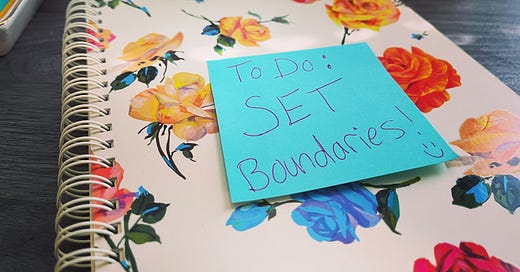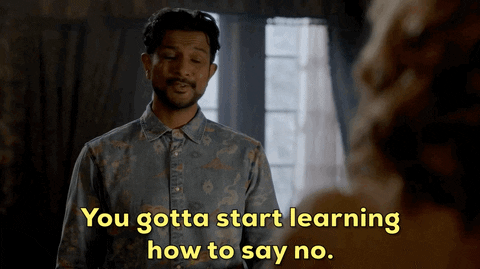It’s fair to say that for most of my life I had absolutely no idea how to have healthy boundaries. Or any boundaries, really. I was mostly a limitless, beautiful blob of unencumbered accessibility, oversharing, and people pleasing just floating through life asking everyone if they’re mad at me.
Since starting my healing journey about fifteen years ago, I have learned so much about how to create, share, and maintain healthy boundaries and expectations in relationships of all kinds aaaaand have had years of practice in failing miserably at all of it and then getting back up and trying again.
Practice makes…better! (See, I didn’t say perfect. GOOD MENTAL HEALTH BOUNDARIES!!)
Phew! Boundaries are HARD y’all!
And that’s because there are a lot of people out in the world who have no idea how to set or accept healthy boundaries themselves.
So when we try to have healthy boundaries with folks who aren’t familiar with them, it can feel very personal and even offensive to them. They may push back on our boundaries or refuse to respect them.
And it is for this very reason boundaries are so vital to everyone’s well-being.
If everyone just treated us the way we deserved and/or asked them to then boundaries wouldn’t be necessary. But, as we have all experienced in our lives, even good people with the best of intentions (but especially people with not-so-good intentions) need us to set firm, healthy boundaries in our relationships for our own well-being, but also for theirs.
Every aspect of setting healthy boundaries is complicated. YAY!
Let’s take a look at the basic steps:
Figure out what you want/need in order to feel loved, safe, respected, healthy, etc.
Honestly, the first step can be the hardest for anyone who is just getting started on setting healthy boundaries (or anyone reevaluating their boundaries and resetting them). And that’s because it takes time, bravery, and effort to figure out what we actually want and need in the first place; let alone actually ask for it from another person.
If you’re a people pleaser or have been codependent in any of your relationships, then you may have lost touch with your own wants, needs, and desires. Maybe you’re not sure where to start in finding yourself again.
You’re not alone.
In order find ourselves again we have to allow ourselves to grieve and mourn what we’ve lost of ourselves. Taking time to acknowledge the truth of what you have lost during times of not having healthy boundaries will help you remember just how important your needs, desires, and wants are to you AND to those around you who will love you in respectful and healthy ways. While you are searching for who you are and what you want, try revisiting the last things you remember bringing you joy. I just saw a sticker book for adults the other day and I squealed with joy thinking about how happy it used to make me to collect stickers in my sticker book when I was a kid. Just because I’m 42 doesn’t mean I can’t revisit my childhood and use what brought me joy then to heal me now.
Be it a sticker book, a hobby, music, art, running, etc, reconnect with the things that bring you joy. This should help you start to find yourself again.
Once you know what you want and need, it is time to turn those wants and needs into healthy boundaries, BAYBEE!
Let’s start with an example of what it looks like to turn needs into boundaries.
I realized one day I desperately needed more quiet time built into my day. As someone who is autistic and ADHD I have sensory processing issues that can make certain noises and sounds actually painful in my body and very uncomfortable in my mind- especially when there seems to be no end to the noises or escape from them (ie: CHILDREN)
So let’s say that on said day of realization, I gently yelled “OOMMGGG!! I NEED MORE QUIET IN THIS HOUSE!!!!! I’M GOING TO THE BEDROOM! DO NOT FOLLOW ME! DO NOT COME IN!!” at my precious family and then proceeded to kindly stomp off to our bedroom and lovingly slam the door and lock it, whilst still strongly emoting my overwhelm from the pile of pillows of which I had buried my face.
This may have happened 8 years ago. It may have happened yesterday. It may have been both.
The point is, ‘twas at that point I realized, after T pointed it out to me, that I may need to have better boundaries around getting the quiet time I need.
I knew in the depths of my marrow I needed more quiet time, but I felt like there was no possible way to get it with two very not-quiet kids sharing this house with me; getting ever louder with every shush and/or hush.
So I just didn’t ask for it.
This is a case of knowing what I needed or wanted but didn’t ask for it because I had already decided it wasn’t possible.
However, when T and I put our heads together, we were able to come up with some boundaries and solutions that have really helped.
One of the things I came up with was as soon as I notice noise is starting to irritate me, but before I am filled with LOVING rage, I put in ear plugs (which will allow me to still hear in case of emergency, but muffles things enough that it doesn’t feel like every sound is a drill directly into my brain and soul okthankyouverymuch) to help me keep from hitting sensory overload.
Any time I am putting in my ear plugs I announce to the kids I’m putting them in just so they know that yelling for me from the downstairs bathroom with the door closed isn’t going to work, and then I enjoy the muffled ambient sounds of two children fighting over one tiny lego piece of which we have 25 thousand of the same.
I wear ear plugs when I’m cooking and the oven vent drives me crazy, or when all our neighbors decide it is time to run their leaf blowers simultaneously, and so on. It’s always ear-plug-o’clock around here, is what I’m trying to say.
Another good solution, thought up by T, was that after dinner every evening, I head up to our bedroom and spend alone time doing whatever I want (JK - I am doing laundry) until it’s time to put the kids to bed. This is basically one hour of built-in quiet time every.damn.day.
Yes, the kids regularly still come in my room even though they are fully aware this is mom’s quiet/alone time, but instead of letting them in or negotiating with terrorists them, all I do is reinforce my boundaries every time. “This is my alone time. If you need anything, your dad is a fully capable human whom, before you ran up here, was located within an arms reach from you. I’ll see you in a few minutes for bedtime.”
Door closes, curtain falls on another unsuccessful attempt by my children to break every single boundary I have ever set for them throughout all of space and time.
Now that we know what we want and need and have some well-defined boundaries cooked up, it’s time to share them with others! AND THEY LOVE IT SO MUCH! WOOHOO!
The hardest part about sharing our boundaries is the fear of rejection. We fear that if we ask for what we want and need it will be too inconvenient or “too much” for others and instead of working on honoring our healthy boundaries they will refuse or leave.
And that is a very real risk. And risks can really suck sometimes.
BUT - it is also the purpose of establishing healthy boundaries.
The key to sharing your boundaries and expectations is to be clear and firm. Depending on the situation, it may also be the time to share what you will do to enforce your boundaries should they not be respected or met. If we want to give people an honest chance to meet our needs in healthy ways, we want to do our very best to be vulnerable and brave in clearly saying exactly what we need.
Sometimes talking face-to-face can be overwhelming. Especially with someone who you may struggle to be honest with. In that case, there is nothing wrong with emailing or messaging your clear and firm boundaries. This can give you time to share exactly how you want to, and it can give the recipient time to think about what you have shared before they respond.
Ask if they have any questions about what you are sharing so you can both be sure of expectations moving forward.
Ok, we are on a roll. We know what we want and need, we’ve shared our boundaries with others, and now it is time to enforce the boundaries we have set.
Every time I share a boundary with someone it goes SUPER WELL and I never have to talk about it again. YAY HUMANITY!!
JUST KIDDING!
It’s one thing to set a healthy boundary with someone. It is a whole other thing to enforce that boundary when that person doesn’t honor it.
Healthy confrontation can be really challenging for people. Learning how to talk vulnerably about how you are feeling without being too passive, too aggressive, or without being passive-aggressive can feel very scary and raw.
If others aren’t able or willing to love and respect us in the ways we need, then having boundaries helps us know this. Once we know where they stand, then we can decide what we want to do with this information.
When someone doesn’t honor a boundary it is important that we practice healthy confrontation so that we can hold that boundary and allow the other person to be responsible for how they feel about it instead of trying to “rescue” them from the discomfort they feel from being confronted. We are responsible to set clear boundaries and reinforce them. We are NOT responsible for how the person will feel or react to our boundaries.
Practice sitting it in the discomfort and learn to let people be upset with you or be upset with themselves without feeling you have to intervene, apologize, or intervene.
For example, many years ago I became friends with someone who was a friend of a friend. At first she and I seemed to get along really well and had a lot in common. But after a while she started to text and call me all the time expecting an immediate response. If I didn’t respond right away, she would text and call again asking why I wasn’t responding.
To me, this felt akin to someone peeking in my window. It felt violating in ways I didn’t really understand when it first starting happening. I just knew it made me feel a lot of pressure. At first I tried to joke with her about it. And we would laugh, but then she would keep doing it. It got to a point that I wanted to run away from our new friendship.
So I decided to try out these fancy new “healthy boundary” things I had been hearing so much about.
I wasn’t brave enough to talk to her about it in person, but I sent her a message. I was calm and kind, but also firm. I expressed how much I enjoyed our new friendship, but I also told her I didn’t like being expected to be constantly readily available any time she texted or called. I told her moving forward I would like less texts and calls, but even then I will only be responding when and if I want to.
I didn’t hear from her for a few days. But then she wrote me back.
She was angry and hurt. She said if I didn’t have time for her in my life then we just shouldn’t be friends at all. She denied calling and texting too much and said it must be only my issue because the rest of her friends never complain.
Part of me, when reading her response, wanted to feel like I had done something wrong. That I was the issue and I was the one who needed to lighten up and change. I didn’t like that she was upset at me.
But, thankfully, a larger, more confident part of me took charge and realized that based on her response, she and I just didn’t seem to be a good friendship match. Her needs and wants didn’t match my needs and wants.
She had her boundaries (she needs more frequent connection than I can give her) and I had mine (I need more space in relationships and don’t like feeling expected to be readily available at all times).
As simple (and as complicated) as that.
I wrote her back and calmly, kindly, and yet firmly reinforced by boundaries by telling her if she didn’t feel the same way as I did about communication then we may not be a good match. She never responded.
And that’s okay.
Sometimes we have to let go. Not necessarily because someone has done something egregious. But because our wants and needs and theirs don’t match up.
Things don’t have to be egregious or seriously abusive to be unhealthy for us.
Reinforcing boundaries is risky because sometimes it will mean having to shift, change, or let go of a relationship. And that can be very hard to do. But, the more you honor your own boundaries the more people you will bring into your life that will love and respect you the way you deserve. Surrounding yourself with people who have and honor healthy boundaries will make your life more fulfilling and enjoyable.
And sometimes it’s not that we have to cut people entirely out of our lives, there are circumstances where moving someone’s access to you from “all-access pass” to “sitting in the nose-bleed section” or even “sitting in the parking lot” is not only doable, but necessary for your well-being.
It’s important to keep in mind that learning to follow someone’s boundaries, and learning to set and enforce boundaries can take a good bit of time, trial-and-error, and practice to get it right. If you can tell someone is doing their best to honor and respect your boundaries and love you well, a period of patience and grace will go far in developing a healthy relationship. This doesn’t mean someone gets unlimited chances, that’s not how healthy boundaries work, it just means that it can take everyone time to get into a rhythm of setting and honoring boundaries - especially if this is something new for one or both of you.
In this next section, I want to talk about why I keep saying “healthy boundaries” and not just “boundaries”.
I think it is important to delineate between healthy and unhealthy boundaries.
Healthy boundaries and expectations are the kind of boundaries that encourage mutual respect and help everyone involved feel safe and comfortable.
But there are such things as unhealthy boundaries and expectations. A good example is the one I just gave above regarding my new friend who wanted nonstop access to me at all times.
What she was wanting from me was to have “no boundaries” in our relationship and that is always unhealthy. Wanting unmitigated access to someone is not healthy for either person involved and therefore honoring her unhealthy boundary is the same as not reinforcing my healthy ones.
Just because someone tells you what they want and need from you for them to feel safe, comfortable, and respected doesn’t always mean what they want and need is HEALTHY or matches your needs for the same.
Boundaries aren’t magical, but they sure can feel like it in the ways they empower us to control what we can control in life and let go of what we can’t.
The key is to not give up on your journey of setting and enforcing healthy boundaries in your life. Any time you start to feel selfish to “too much” or want to hide away your needs like a pirate burying treasure, please remind yourself that your healthy boundaries and self care help you be the best version of yourself AND they help others learn how to love you well. Another great thing is it encourages other to also have healthy boundaries in their own lives.
When I need time away from my kids, I am not being a bad mom or being neglectful and selfish. I am refueling and resting while also teaching them that it is okay for THEM to also have time away to rest and get what they need.
Wherever you are on your Healthy Boundaries journey, please be encouraged that you are doing the right thing. Time spent working on this is time well-invested.
Here are a few resources below regarding Healthy Boundary work for adults, teens, and kiddos:
Braving the Wilderness by Brené Brown (or really ANY book by Brené Brown)
Boundaries by Dr. Henry Cloud and Dr. John Townsend
Co-Dependant No More by Melanie Beattie
Let That Sh*t Go: A Journal for Leaving Your Bullsh*t Behind and Creating a Happy Life by Monica Sweeney
Recovery from Co-Dependancy a Practical Guide by Carrie Wolf
The Better Boundaries Workbook by Sharon Martin MSW LCSW
Consent (for Kids!): Boundaries, Respect, and Being in Charge of YOU by Rachel Brian
Divergent Mind: Thriving in a World That Wasn’t Designed for You by Jenara Nerenberg
Life Skills Workbook for Adults with Autism and Special Needs: Activities to help Develop Independence, Self-Advocacy, and Self Care by Susan Jules
Let's Talk About Body Boundaries, Consent and Respect: Teach children about body ownership, respect, feelings, choices and recognizing bullying behaviors by Jayneen Sanders
Where Hands Go: An Introduction to Safe and Unsafe Touch by Kristaelynne Sanders Diggs
Self-Love Workbook for Women: Release Self-Doubt, Build Self-Compassion, and Embrace Who You Are by Megan Logan MSW LCSW









Your ideas of setting boundaries are great for everyone. It’s hard to tell someone that you want more or less or none but being honest about what makes you feel happy and comfortable is always the best.